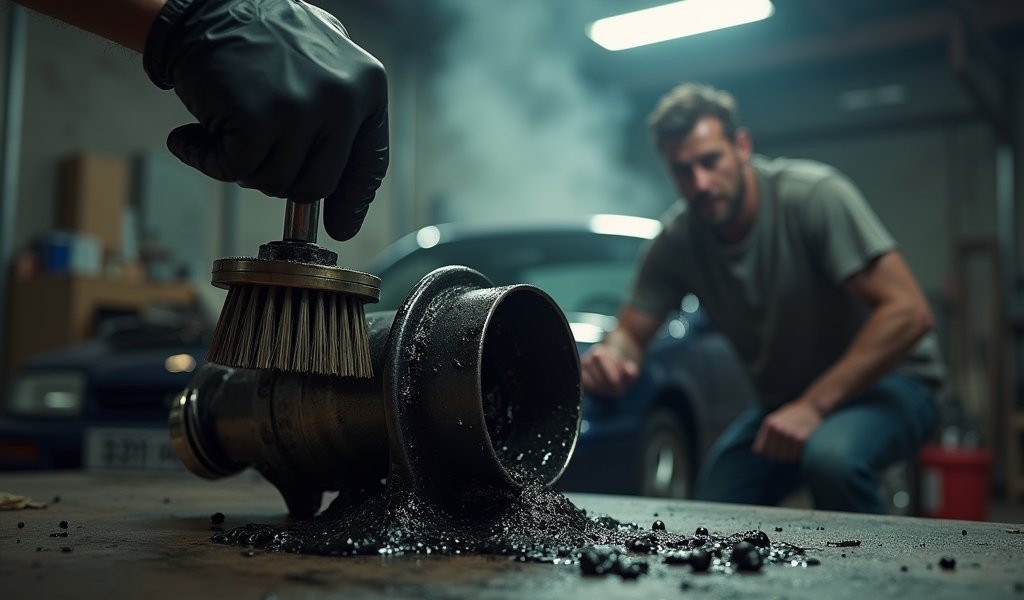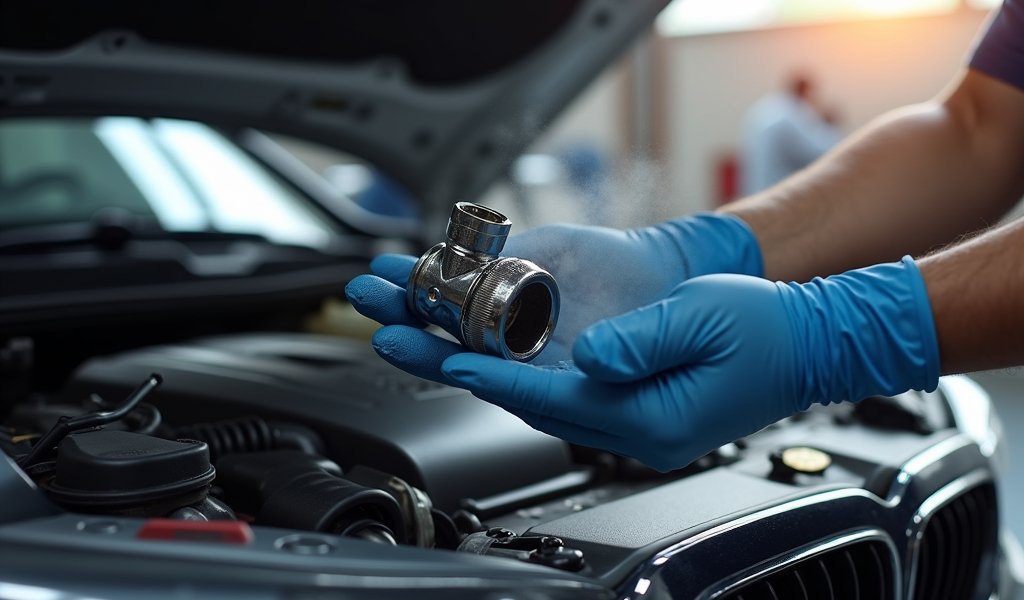Overview
This guide explains how to clean a clogged EGR valve, covering symptoms like rough idling and reduced fuel economy, the step-by-step cleaning process, and preventative maintenance tips. Regular cleaning of this emissions control component can restore engine performance, improve fuel economy, and prevent costly repairs while reducing harmful emissions.
Table of Contents
- What is an EGR Valve?
- Signs Your EGR Valve is Crying for a Clean-Up
- Why Cleaning Your EGR Valve is Worth Your Time
- Tools You’ll Need For the Job
- The Step-by-Step Cleaning Process
- Keeping Your EGR Valve Happy: Preventative Tips
- Conclusion
- Frequently Asked Questions
What is an EGR Valve?
Think of your exhaust gas recirculation valve as your engine’s eco-friendly recycling system. This humble component works tirelessly behind the scenes, redirecting a portion of your exhaust gases back into the combustion chamber instead of sending them straight out the tailpipe. Why does it bother? Well, this little trick actually cools down your engine’s combustion temperatures, which cuts down on those nasty nitrogen oxide emissions that make Mother Nature frown.
The EGR valve is like the bouncer at an exclusive club, controlling exactly how much exhaust gas gets invited back to the party. When it’s working properly, your engine runs smoother than butter on a hot skillet, your fuel economy stays healthy, and your emissions remain environmentally friendly. But when this valve gets gunked up with carbon deposits (and boy, does it love to collect them), it starts throwing tantrums that your whole car can feel.
Most modern vehicles use one of two types of EGR valves: vacuum-operated (the old-school approach) or electronically controlled (the new hotness). Either way, their mission remains the same – keeping your combustion temperatures down and your emissions in check. Without this crucial emissions component doing its job, your engine might run hotter than a jalapeño on a Texas sidewalk in August.
Signs Your EGR Valve is Crying for a Clean-Up

Your car might not speak English, but it sure knows how to communicate when something’s wrong. When your EGR valve gets clogged, your vehicle will start dropping hints more obvious than a dog sitting by its empty food bowl. Here are the telltale signals that your EGR valve is begging for some TLC:
- Your engine idles rougher than a wooden roller coaster, sometimes feeling like it might stall out completely
- Your car hesitates when accelerating, as if it’s pondering whether it really wants to go faster
- That dreaded check engine light illuminates on your dashboard like an unwelcome holiday decoration
- Your vehicle suddenly develops a drinking problem – guzzling fuel like it’s going out of style
- A noticeable drop in engine performance makes you wonder if someone stole half your horsepower overnight
- You catch a whiff of something that smells like rotten eggs when you step on the gas
- Your car fails an emissions test, despite looking perfectly fine otherwise
If your vehicle is exhibiting three or more of these symptoms, there’s a good chance your EGR valve is clogged up tighter than a drain at a hair salon. The good news? You don’t need to be a certified mechanic with decades of experience to fix this. With some basic tools, a bit of patience, and this guide, you’ll have that valve singing again in no time.
I’ve seen EGR valves so caked with carbon they look like they’ve been dipped in black cement. Even valves in this sorry state can usually be restored to near-perfect condition with a thorough cleaning. Your wallet will thank you for taking the DIY approach – a replacement EGR valve can cost anywhere from $150 to $500, while cleaning supplies run about the price of a decent pizza.
Why Cleaning Your EGR Valve is Worth Your Time
Before we roll up our sleeves and get our hands dirty, let’s talk about why this maintenance task deserves a spot on your automotive to-do list. Cleaning your EGR valve isn’t just about fixing current problems – it’s preventative medicine for your engine’s long-term health.
A clean EGR valve improves your fuel economy faster than a crash diet. When your valve is gunked up, your engine compensates by using more fuel to maintain performance – kind of like how you’d work harder to breathe through a straw than through an open pipe. By keeping that valve clean, you could save yourself hundreds of dollars at the pump over time.
Your engine’s lifespan gets a serious boost, too. Lower combustion temperatures mean less stress on your engine components, similar to how keeping your body temperature normal helps you function better. Plus, you’ll be doing your part for cleaner air by ensuring your vehicle’s emissions system works as designed, according to the EPA’s guidelines on vehicle emissions.
Most importantly, addressing EGR issues early prevents them from snowballing into bigger, more expensive problems. It’s the automotive equivalent of treating a cold before it turns into pneumonia. I’ve seen neglected EGR systems lead to damaged intake manifolds, failed catalytic converters, and even cylinder head problems – repairs that can cost thousands rather than the pocket change of a DIY cleaning.
Tools You’ll Need For the Job
Let’s gather our cleaning arsenal before we dive in. Think of this as preparing for battle against the carbon buildup that’s been holding your engine hostage. Here’s what you’ll need to emerge victorious:
Cleaning Supplies:
- EGR valve cleaner spray (carburetor or throttle body cleaner works in a pinch)
- Pipe cleaners or small wire brushes (perfect for getting into those nooks and crannies)
- Clean shop rags (you’ll need more than you think)
- Plastic scraper or soft wire brush (metal scrapers are like sledgehammers at a watch repair – too aggressive)
- Small container for soaking parts (an old plastic container works perfectly)
- Compressed air (optional but handy as a horse on a cattle drive)
Safety Gear (Don’t Skip This!):
- Safety glasses or goggles (your eyes are irreplaceable)
- Chemical-resistant gloves (your skin will thank you)
- A well-ventilated workspace (breathing cleaning fumes is nobody’s idea of a good time)
Tools for the Job:
- Basic socket set and/or wrench set (metric or standard depending on your vehicle)
- Screwdrivers (flathead and Phillips)
- Pliers (regular and needle-nose can both come in handy)
- Torque wrench (not absolutely necessary but recommended for proper reinstallation)
- Gasket scraper (for removing old gasket material without scratching mating surfaces)
- Shop vacuum (optional but useful for cleaning up debris)
Don’t be intimidated by this list – you probably have most of these items already. If you need to purchase anything, consider it an investment in your automotive toolkit. These tools will serve you well for countless other maintenance tasks down the road. As my old shop teacher used to say, “The right tool makes any job half as hard and twice as good.”
One last tip: before you start, make sure you have enough time set aside. This isn’t a rush job – give yourself about 2-3 hours if it’s your first time. There’s nothing worse than having to put your car back together half-finished because you ran out of daylight. Trust me, I’ve been there!
The Step-by-Step Cleaning Process

Now for the main event – getting that EGR valve clean enough to eat off of (though I wouldn’t recommend actually dining on it). Follow these steps, and you’ll transform your carbon-caked valve into a like-new component that performs like a dream.
1. Locate Your EGR Valve
The EGR valve typically sits on the intake manifold or on the side of the engine block. It usually has vacuum lines and electrical connections attached to it, making it look something like a metal mushroom with hoses. If you’re having trouble finding it, your owner’s manual is your best friend here. Can’t find the manual? A quick online search with your vehicle’s make, model, and year plus “EGR valve location” should point you in the right direction.
2. Preparation is Key
Make absolutely sure your engine is cool to the touch before starting – working on a hot engine is like trying to fix a lit firecracker. Disconnect the negative terminal of your battery to prevent any electrical surprises. This is also a great time to put on those safety glasses and gloves we talked about earlier.
3. Document Before You Disconnect
This step has saved my bacon more times than I can count. Take clear photos of the valve and all its connections from multiple angles before you remove anything. These visual breadcrumbs will guide you home during reassembly when your memory inevitably fails you about which hose goes where.
4. Remove the Valve
Carefully disconnect any electrical connectors and vacuum lines attached to the valve, labeling them if necessary. Remove the mounting bolts or nuts that secure the valve to the manifold or engine block. Keep track of these fasteners – they have a magical ability to disappear when dropped.
If your valve has a gasket, carefully remove it and inspect it for damage. A damaged gasket is like a leaky boat – it won’t do its job properly and needs replacement. New EGR gaskets are inexpensive and worth the peace of mind.
5. Inspection Time
With the valve removed, take a good look at what you’re dealing with. A properly functioning EGR valve should have a pintle (that’s the valve stem) that moves freely when pressed. If yours is stuck stiffer than your grandfather’s knee on a cold morning, you’ve definitely found your problem.
6. The Deep Clean
Now for the satisfying part:
- Spray your EGR cleaner generously on all carbon-affected areas. Let it soak in like rain on dry earth – this stuff needs time to work its magic.
- After the recommended soaking time (check the product label), use your soft brushes and plastic scrapers to gently remove the softened carbon deposits.
- For particularly stubborn areas, place the valve in your container and soak it in cleaner for a longer period.
- Once the majority of carbon is removed, use pipe cleaners to reach those tight spaces and passages where carbon loves to hide.
- Finish with compressed air to blow out any remaining debris and cleaning solution.
- While you’re at it, clean the EGR passages in the manifold too. These can get just as clogged as the valve itself.
Take your time with this step. Carbon buildup can be more stubborn than a mule at bath time, but persistence pays off. You’ll know you’re done when you can see the metal surfaces again and the pintle moves freely with a spring-like action.
7. Putting it All Back Together
Reassembly is like a reverse dance of the disassembly:
- Replace any damaged gaskets with new ones.
- Position the valve back in its original location.
- Tighten mounting bolts to the manufacturer’s specifications (this is where that torque wrench comes in handy).
- Reconnect all vacuum lines and electrical connections according to your photos.
- Double-check that everything is secure and properly connected.
- Reconnect the battery.
8. The Moment of Truth
Start your engine and check for any leaks around the EGR valve. Take your car for a test drive to see if the symptoms have improved. Your engine should run smoother than a jazz saxophone solo, idle steadier than a surgeon’s hand, and accelerate more eagerly than a dog chasing a squirrel.
If you’re still having issues after cleaning, it might be time to consider whether the valve itself has mechanically failed and needs replacement. Even the best cleaning can’t fix broken internal components. In this case, professional diagnostic service might be your next step.
Keeping Your EGR Valve Happy: Preventative Tips
An ounce of prevention is worth a pound of cure, especially when it comes to EGR valves. Here are some tips to keep yours cleaner longer:
- Take the long way home sometimes. Short trips where your engine never fully warms up are like fast food for your EGR valve – they cause rapid carbon buildup. Try to mix in regular highway driving to help clear things out.
- Feed your car the good stuff. Higher quality fuels generally produce fewer carbon deposits. They cost a bit more, but think of it as serving your car a healthy meal instead of junk food.
- Keep up with regular maintenance. Regular oil changes with the correct oil grade help reduce carbon deposits throughout your engine, according to research from the Society of Automotive Engineers.
- Consider fuel system cleaners. Adding a quality fuel system cleaner to your tank every few months can help keep carbon deposits at bay. It’s like giving your engine a mini detox.
- Pay attention to warning signs. If you notice your engine beginning to run rough or your fuel economy dropping, don’t wait until the problem gets worse. Early intervention can save you time and money.
I recommend inspecting your EGR valve every 50,000 miles as part of your routine maintenance. However, if you primarily drive in city conditions with lots of stop-and-go traffic, you might want to check it more frequently – perhaps every 30,000 miles instead.
Remember, carbon buildup is a normal byproduct of combustion, just like dust in your house is a normal byproduct of living. Regular cleaning is just part of responsible vehicle ownership, like changing your oil or rotating your tires.
Conclusion
Cleaning your exhaust gas recirculation valve might not be the most glamorous weekend project, but it’s certainly one of the most rewarding. A couple of hours of your time and a few dollars in supplies can restore lost performance, improve fuel economy, and extend your engine’s life – not a bad return on investment!
Think of EGR valve maintenance as a form of automotive healthcare. Just like you wouldn’t ignore a persistent cough or ache, don’t ignore the signs your vehicle gives when its EGR system is struggling. Your car takes care of you day in and day out; returning the favor with regular maintenance is the least you can do.
Remember, a clean EGR valve is a happy EGR valve, and a happy EGR valve means a happy engine. And a happy engine means more reliable transportation, more money in your pocket, and less stress in your life. Isn’t that worth a few hours in the garage?
The next time your car starts running like it’s got a bad case of the hiccups, you’ll know exactly what to check and how to fix it. And that kind of knowledge doesn’t just save you money – it gives you the confidence that comes from truly understanding the machine you depend on every day.
Frequently Asked Questions
How often should I clean my EGR valve?
Most mechanics recommend inspecting and cleaning your EGR valve every 50,000 miles. If you drive primarily in city traffic or take many short trips, consider checking it every 30,000 miles instead.
Can I just remove or disconnect my EGR valve to solve problems?
No, removing or disconnecting your EGR valve can trigger check engine lights, cause your vehicle to fail emissions tests, and may be illegal in many areas. It can also lead to increased engine temperatures and potential damage.
How can I tell if my EGR valve needs replacement instead of cleaning?
If the valve doesn’t improve after a thorough cleaning, or if the pintle is mechanically damaged, replacement is necessary. Electronic EGR valves may also fail if their sensors or solenoids stop functioning properly.
Will using premium fuel prevent EGR valve clogging?
Premium fuel can help reduce carbon deposits but won’t eliminate them completely. It’s still beneficial to inspect and clean your EGR valve at regular intervals regardless of fuel type.
Can I clean my EGR valve without removing it?
While some aerosol cleaners claim to work without removal, they typically only help with minor buildup. For heavily clogged valves, physical removal and manual cleaning provide the most thorough results.


Pingback: EGR Cooler Bypass Valve: 5 Proven Fixes - knowsyourcar.com